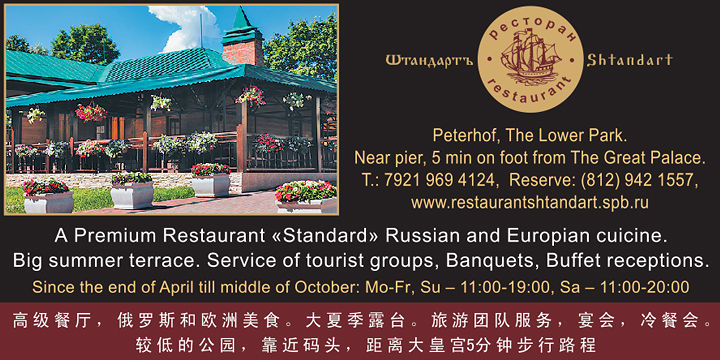PETERHOF
Peterhof is located 30 km west of St. Petersburg, on the shore of the Gulf of Finland, and is best known for its unique fountains and cascades, luxurious palace and park pavilions, numerous gilded statues of ancient gods and heroes and remarkable collections of sculpture and paintings.
The origin of Peterhof dates back to 1704 when Peter the Great had a small timber house built close to the shore, so that he could reach the newly built fortress Kronshtadt located further west on the island of Kotlin without a long and possibly dangerous journey. After the victory of Poltava in 1709 and naval victory at Gangut, Peter decided to transform this site into city-monument that would glorify the might of the Russian Empire. In 1714 architects Johann Friedrich Braunshtein and Jean-Baptiste Le Blond were commissioned to build the palace and to create the architectural ensemble of the park. By 1723 the Upper and Lower Parks, the Grand Palace, Monplaisir and Marli Palaces had all been completed and magnificent Peterhof (German name for Peter’s Court) was inaugurated as an imperial residence. During the reign of Empress Elizabeth, further alterations were done by architect Bartolomeo Rastrelli.
After 1917 the Peterhof ensemble was taken into state custody, and turned into architectural and art museum. Nowadays Peterhof has become one of the most attractive destinations for tourists.
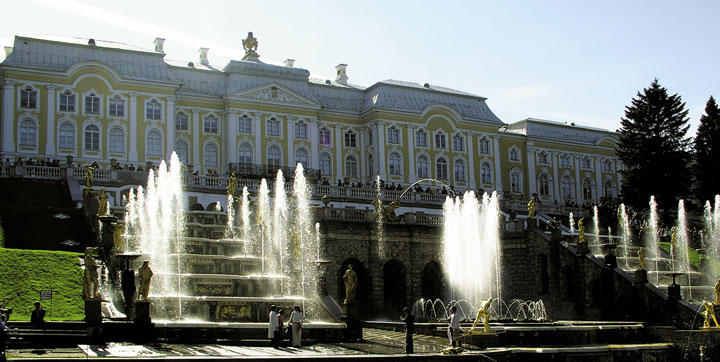
The Great Palace, whose facade extends for about 300 meters, is the focal point of the palace and park ensemble. It was originally designed for Peter the Great by architects Jean-Baptiste Le Blond, Johann Friedrich Braunstein, Niccolo Michetti and Mikhail Zemtsov between 1714 and 1725. During the reign of Peter’s daughter Elizabeth the original palace proved inadequate to the official needs of the imperial court and so in 1747-1752 it was considerably enlarged by architect Bartolomeo Rastrelli. Decades later, much of the interior was redesigned by Jean-Baptiste Vallin de la Mothe and Yuriy Felten, with further alterations made in the mid 19th century.
Adjoining the Great Palace to the south, the Upper Garden covers an area of 15 ha between the facade of the palace and the main road to St. Petersburg. The Garden’s centerpiece is the Neptune Fountain originally built for the Numberg Marktplatz and never used, ending up in Peterhof after Emperor Paul I bought it during one of his trips to Germany.
From the terrace by the north facade of the Great Palace you have a splendid view of the Lower Park. Located between the Great Palace and the Sea, the 102-ha Lower Park was set out like a typical formal French garden. As in Versailles it was originally conceived as a park with fountains. Nowadays the Lower Park contains 173 fountains and 4 cascades.
The main structure of the majestic fountain system of the Lower Park is the Great Cascade. By its dimensions, abundance of water, rich sculpture, variety of jet patterns and remarkable overall unity this splendid specimen of Baroque art is one of the finest fountain ensembles in the world. All decorations of the Great Cascade are aimed to introduce Russia as a strong sea power. From the top of the cascade water pours out in 2 streams from the mouth of 2 heads representing Neptune, God of the Sea. It flows downwards via the aquatic stairway and falls down on the lower oval terraces. Here stand the figures of an old man with an oar and a young woman, representing the Russian rivers Volkhov and Neva. Continuing its downward journey the water flows into a reservoir in the center of which on a huge rock pedestal stands the statue of Samson rending the jaws of a lion. The fountain celebrates Russia’s victory over Sweden in the Northern War: the decisive battle of Poltava occured on the feast day of St. Samson in 1709, and therefore the historic battle is represented allegorically as a fight of the Biblical Samson with a lion (the lion was the heraldic beast of Sweden). The fountain spurts a powerful water jet to the height of 20 meters. Eight dolphins send out jets at the giant’s feet, symbolizing the peace of the sea. Four lions with water streaming from their jaws sit in recesses on the 4 sides of the rock pedestal. They symbolize 4 parts of the world amazed by a glorious victory of Samson over the lion.
From the foot of the Great Cascade the central Marine Canal flows into the Gulf of Finland, splitting the Lower Park into west and east sections.
The main feature of water display in the east section of the Lower Park is the Chessboard Hill Cascade also known as Dragons’ Cascade. Its 4 huge sloping steps are painted in a black-and-white zigzag pattern, like a chessboard. At the foot and top of the cascade are grottos. The entrance to the upper grotto is guarded by 3 dragons from whose open jaws powerful jets of water shoot up and fall down the steps into the figured pool below.
At the foot of this waterfall is a piazza dominated by 2 twin Roman Fountains. In design they are similar to the fountains in front of St. Peter’s in Rome, hence the name. Each fountain is made up of two octagonal forms – a small one, placed on top of a larger one – each supporting a disc.
From the piazza several paths run out radially. The path running to the northeast leads to the Pyramid Fountain – one of the most remarkable of the Peterhof fountains. Its design accentuates the regular geometrical pattern formed by the jets. 505 of them, rising above each other in 7 tiers, make up a four-sided watery pyramid.
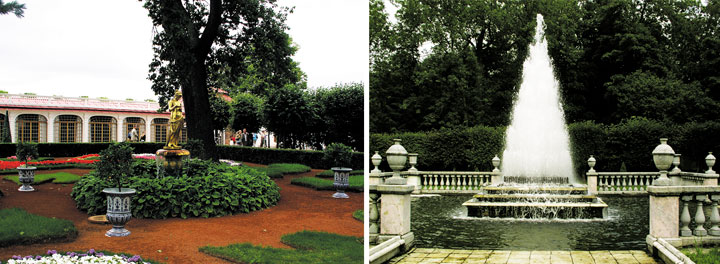
Retrace your steps to the piazza and continue on towards the sea. On your right you will soon notice the Sun Fountain. In the middle of a rectangular pool, 16 dolphins, arranged in a circle, blow curving jets of water which form a transparent, lacy goblet. In the middle stands a tall pillar topped with a gilded disk, rotating slowly round its vertical axis while the rim throws out 5 jets of sparkling water in imitation of the sun’s rays.
If you are not afraid to get soaked, stop near trick fountains. The Umbrella starts raining when you sit underneath it, as does the Spruce Fountain, which resembles trees.
Further downhill, sited on the seafront, is Peter the Great’s favorite house, Monplaisir (from the French for “my pleasure”). Designed by architects Johann Friedrich Braunshtein and Johann Schlutter with direct participation of Peter the Great, this low, brick house reflects the influence of Holland, where Peter studied shipbuilding. In Peter’s lifetime the palace was used for small receptions and family celebrations of an intimate nature. The style of its interior has largely survived from Peter the Great’s time.
The adjacent Catherine Wing was added to Monplaisir by Empress Elizabeth in the mid 18th century to accommodate court balls and masquerades. Its name, however, originates from the fact that the Tea House nearby was frequently used as a place of residence by Catherine the Great while she was still the wife of Peter III. There, on the moprning of July 28, 1762 she learned from Aleksey Orlov that the coup against her husband was under way and hastened to St. Petersburg to rally her supporters.
Between the Catherine Wing and Monplaisir lies a Monplaisir Garden. In the center of the garden stands the Wheatsheaf Fountain, whose 25 jets of water are arranged to form a sheaf of rich, ripe wheat. The other 4 fountains in the garden are called the Bells.
Heading westwards from the Monplaisir you will encounter the Adam Fountain. The fountain is organically linked with the landscaping of this part of the park. There are 16 jets around the pedestal of the sculpture pouring water into an octagonal basin, from the sides of which eight paths lead off radially thereby connecting the fountain to the other buildings in the park.
If you move further westwards along the main path from the Adam Fountain, you will soon cross the Marine Canal and enter the west section of the Lower Park.
Beyond the Marine Canal stands the Eve Fountain, Eve with apple and figleaf in hand. From there you can detour northwards to the Hermitage.
As its name implies, the Hermitage Pavilion is situated far from the main paths, by the sea. It is surrounded by a moat with a drawbridge, thus isolating the inhabitants from the world outside. From inside the pavilion consisted of a ground-floor kitchen and a dining room on the upper floor. In the dining room there was a special mechanism which lifted the central section of the table, loaded with the dishes ordered by guests, from the ground floor straight to the upper floor. In this way the invited guests were able to dine in complete privacy, undisturbed even by the staff who served them.
Compositionally linked to the Hermitage Pavilion is the Lion’s Cascade, which lies between the Birch and the Marly Alleys. It was originally built in the early 19th century by Andrey Voronikhin, though 50 years later the whole fountain was reconstructed by Andrey Stakenschneider. The rectangular basin was given an ornamental colonnade of fourteen eight-meter Ionic columns and the figure of a nymph was set up in the center of the basin. Bronze lions were placed near the colonnade and from their open jaws streamed fountains of water. The overall ornamentation of the cascade was completed with addition of 22 mascaron fountains in the form of women’s heads crowned with wreathes.
Returning back to the Marly Alley and walking towards its far end, you will soon reach the small palace known as Chateau de Marly. The palace takes its name and inspiration from the hunting lodge of the French kings at Marly le Rois, which Peter the Great visited during his tour of Europe. It was built in 1720-23 and used primarily to accommodate guests. In front of the main facade of the palace there is a large rectangular pond, which in Peter the Great’s time was full of exotic fish.
South of the pond rises the Golden Hill Cascade, also known as the Marly Cascade. Like the Chessboard Hill Cascade, it is flanked by allegorical statues and offers a ravishing view of the park.
In front of the cascade there are two Menazhernyy Fountains. Their name derives from the French word menager, to economize, since they use less water than their powerful jets suggest.
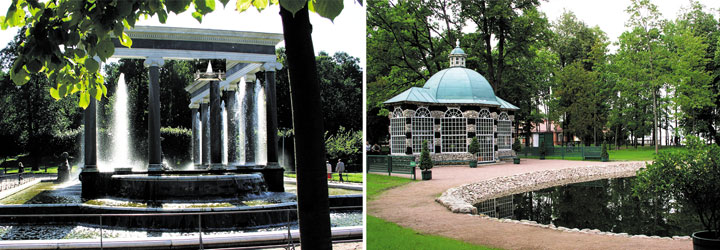
Leaving the west section of the park towards the central area, you will soon come to the Sandy Pond with the Whale Fountain in the center. The hollow menager fountain rises vertically above the still surface of the water, and parabolic jets gush from the jaws of the four glittering dolphins.
As you approach the reservoir that surrounds the Samson Fountain, you will come to the Voronikhin Colonnades, named after the architect who designed this pair of Classical pavilions, which flank the enormous circular basin below the Great Cascade.
Well, our walking tour of the Lower Park ends here. On your way back, return to the terrace in front of the Great Palace to have another look at the magnificent fountains and enjoy their unsurpassable beauty and magic charm.
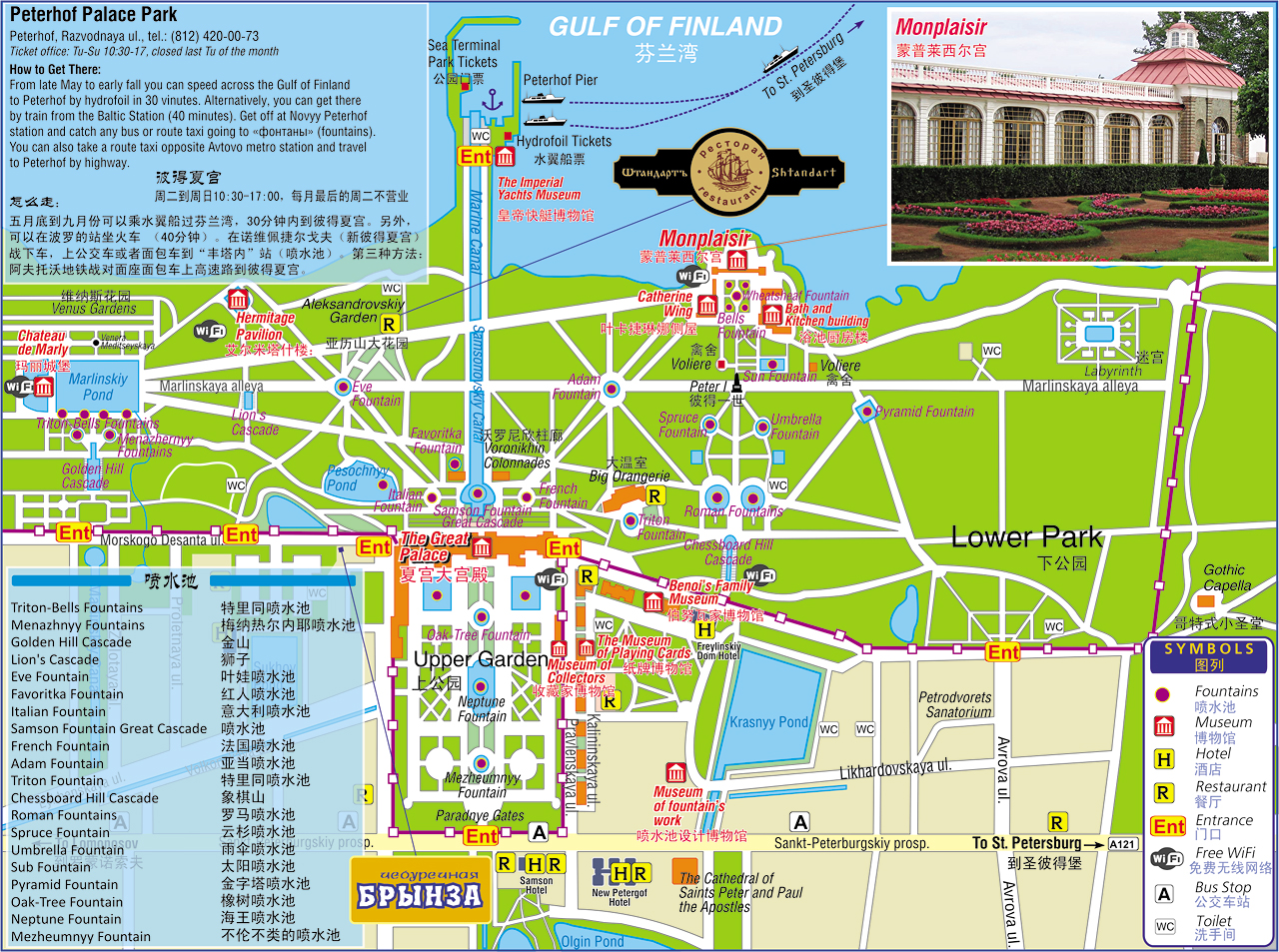
Directions for Visiting: From late May to early fall you can speed across the Gulf of Finland to Peterhof by hydrofoil in 30 minutes. Alternatively, you can get there by train from the Baltic Station (40 minutes). Get off at Novyy Peterhof station and catch any bus or route taxi going to “fontany” (fountains). You can also take a route taxi opposite Avtovo metro station and travel to Peterhof by highway.
